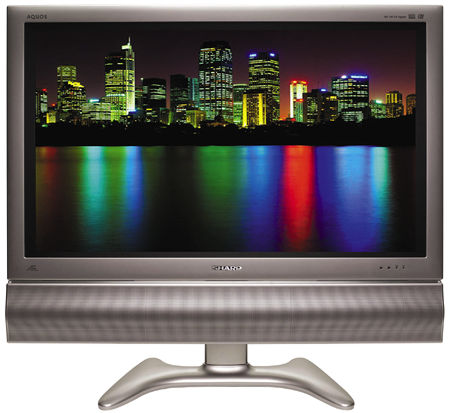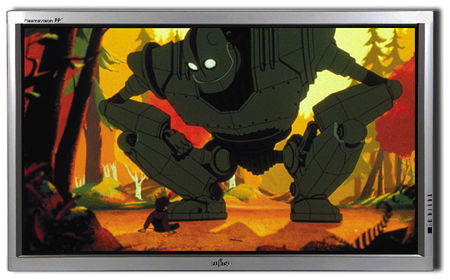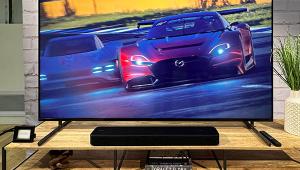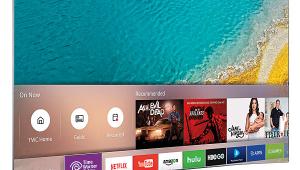Picture This Page 3
• Super-bright (rear-projection designs). A useful advantage in the right situation, but this can make for uncomfortable viewing with films in a theater-like, con- trolled-light environment. It's often impossible to reduce the light output significantly without also degrading the contrast ratio. Front-projection designs do not generally have this problem, and when they do, it can often be controlled by screen size, screen material, and, in some models, a variable bulb setting, adjustable lens iris, or both.
• Still relatively expensive compared to CRT direct-view displays, but generally cheaper than LCoS designs, flat-panel LCDs, and plasmas.
• Blacks and shadow detail. The best front-projection DLPs have satisfyingly deep blacks and contrast ratios, and good shadow detail. But the high-gain screens used (unnecessarily, in our opinion) in rear-projection designs compromise the darkest blacks somewhat—though the blacks are still better than those we've seen from LCD rear projectors.
• Rainbows. This color-fringing phenomenon, caused by the rotating color wheels in one-chip DLPs (it does not affect three-chip designs), results in rainbow-like artifacts that come and go quickly. Many people cannot see them but, for those who can, rainbows occur most often in dark scenes with bright highlights. Design improvements have rendered rainbows far less common than they were in the early days of DLP, but they're still occasionally visible to sensitive individuals on all of the one-chip DLPs we've tested.
• Lamp replacement. See "LCD Disadvantages." The same issues apply to both front and rear DLP projectors.
Liquid Crystal on Silicon (LCoS)
LCoS displays are similar in some ways to LCDs but, whereas LCDs are sometimes referred to as transmissive devices because they control light passing through them, LCoS displays are often called reflective. The designation is a misnomer, however; in an LCoS display, light from the lamp also passes through a liquid crystal panel, is reflected off a mirrored backplane, then passes back through the panel.

While manufacturers claim various advantages for LCoS over LCD, perhaps the most significant is that the control circuits and wiring can be concealed behind the backplane. In a conventional LCD display, the wiring must go into the spaces between the pixels, resulting in wider gaps and more of a "screen door" effect. In an LCoS display, placing the wiring behind the backplane means that the pixels can be more tightly spaced, and the lines between them are therefore much less prominent. LCoS is a microdisplay technology, uses a lamp as a light source, and has been employed, to date, only in front- or rear-projection (not flat-panel) designs. JVC's D-ILA and Sony's SXRD are two proprietary variations of LCoS.
LCoS Advantages
• The best examples offer excellent color quality, good blacks and shadow detail, fine definition, and very good brightness. As with LCDs, there may be some color unevenness across the screen in less capable designs, though it's rarely a distraction on color program material.
• LCoS is the first fixed-pixel front-projection technology to offer (from JVC and Sony) 1920x1080 native resolution, though most current examples are closer to 1280x720. JVC and Sony have demonstrated professional LCoS projectors offering resolutions of about 4000x2000—higher than any other display technology can yet manage.
• Burn-in is not an issue.
LCoS Disadvantages
• Expensive. One-piece, rear-projection LCoS designs are not as pricey as plasmas, and recent models from JVC don't cost much more than DLP rear projectors. LCoS front projectors, however, are still more expensive, on average, than DLP and LCD designs.

• To date, getting an adequate production yield to make the LCoS technology commercially viable has been a major bottleneck. Sony claims to have solved the problem, but we won't know for certain until they or someone else starts shipping LCoS displays in DLP-like numbers.
• Lamp replacement. See "LCD Disadvan-tages," but note that replacement lamps for some LCoS projectors can cost far more—as much as $3000 for the xenon lamp used in the Sony Qualia 004. Check estimated lamp life, warranties, and replacement prices before purchase to make certain your budget can handle the maintenance costs.
Plasma
Think fluorescent light—or, rather, millions of fluorescent lights. Plasma displays are constructed of millions of tiny cells sandwiched between two glass plates. Each pixel is made up of three subpixels, one each containing red, green, and blue phosphors. The cells also contain rare gases, generally xenon and neon. A current passing through the gases excites their atoms. This produces ultraviolet light, which in turn excites the phosphors in the cell and causes them to glow. We can't see the ultraviolet light, but we can see the red, green, and blue light generated by the phosphors. The electric current comes from electrodes on either side of each red, green, and blue subpixel. These electrodes are fired by the set's digital circuits, which are responsible for correctly addressing each subpixel, as required by the source signal.
Plasma Advantages
• The first technology to offer large, flat-panel, widescreen displays, thus realizing the dream of hang-on-the-wall, big-screen TV.
• Retains brightness and overall image quality when viewed from off-axis.
• The best examples offer excellent color quality, very good blacks and shadow detail, fine definition, and very good brightness.
Plasma Disadvantages
• Expensive. The goal of most makers of plasma displays is a price of $100 per diagonal inch. While at least one manufacturer, Panasonic, has said that it expects to reach that goal in the next year or two, that would still mean a 65-inch plasma would cost roughly twice as much as an equivalent (but far bulkier) rear-projection CRT. A word to the wise: Manufacturers are gradually phasing out CRT RPTVs.
• A wide range in quality. Many of the "cheap" plasmas you see in warehouse stores use leftover technology from last year's name-brand models. Some of them are also so-called "enhanced definition TV" (EDTV) sets—i.e., they'll display a high-definition program, and might well look good doing so (particularly the smaller models), but what you see won't be in full high-definition resolution. Some of these cheaper plasmas provide satisfying performance, but don't expect miracles. In a plasma set, you get what you pay for.
• Black level and shadow detail. While the best examples do very well in these respects, some are better than others.
• Fragile. If not carefully handled, a plasma's glass can shatter, making the set a total loss. For this reason, buying a plasma set by mail or online without a guarantee of safe delivery is a chancy proposition. Try to arrange for home delivery and professional setup, particularly if you plan to hang it on the wall (special stands are also available). A wall mounting must not only be secure (particularly in earthquake country!); you'll also have to route and hide the power and signal cables. And no tossing basketballs—or bricks—around the TV room: your rage at that last-second touchdown could cost you thousands of dollars.
• Power consumption. Plasmas burn watts faster than the other display technologies listed here.
• Burn-in. Leave a fixed image on the screen, particularly when the Contrast control is turned up high (which it invariably will be as delivered from the factory), and you could burn a permanent shadow of the image into the screen. Watch only 4:3 programs on your widescreen plasma, and you could also have a problem with uneven wear. The burn-in risk is roughly the same as with a rear-projection CRT (see the CRT section, above, for more on burn-in).















































